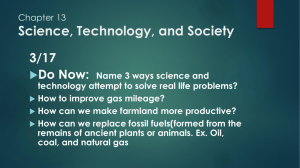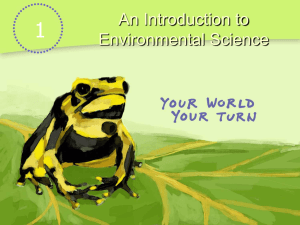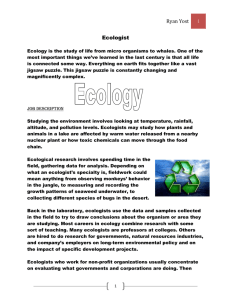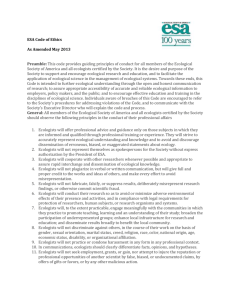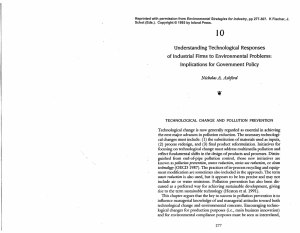NATS 1510 - Introductory Lecture
advertisement
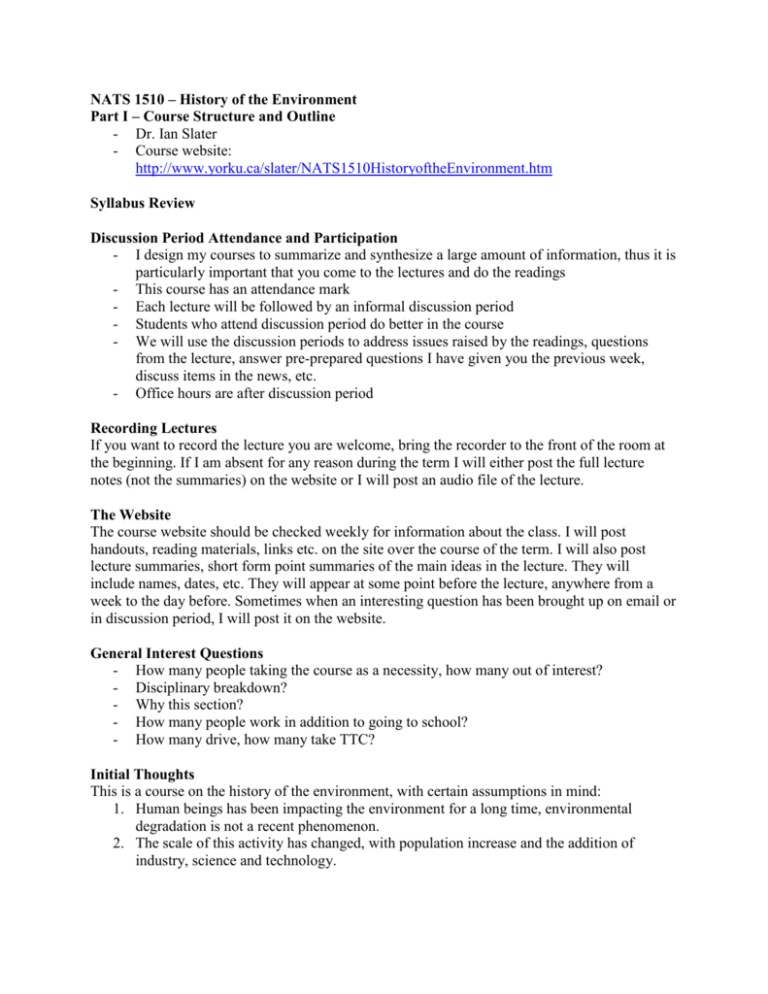
NATS 1510 – History of the Environment Part I – Course Structure and Outline - Dr. Ian Slater - Course website: http://www.yorku.ca/slater/NATS1510HistoryoftheEnvironment.htm Syllabus Review Discussion Period Attendance and Participation - I design my courses to summarize and synthesize a large amount of information, thus it is particularly important that you come to the lectures and do the readings - This course has an attendance mark - Each lecture will be followed by an informal discussion period - Students who attend discussion period do better in the course - We will use the discussion periods to address issues raised by the readings, questions from the lecture, answer pre-prepared questions I have given you the previous week, discuss items in the news, etc. - Office hours are after discussion period Recording Lectures If you want to record the lecture you are welcome, bring the recorder to the front of the room at the beginning. If I am absent for any reason during the term I will either post the full lecture notes (not the summaries) on the website or I will post an audio file of the lecture. The Website The course website should be checked weekly for information about the class. I will post handouts, reading materials, links etc. on the site over the course of the term. I will also post lecture summaries, short form point summaries of the main ideas in the lecture. They will include names, dates, etc. They will appear at some point before the lecture, anywhere from a week to the day before. Sometimes when an interesting question has been brought up on email or in discussion period, I will post it on the website. General Interest Questions - How many people taking the course as a necessity, how many out of interest? - Disciplinary breakdown? - Why this section? - How many people work in addition to going to school? - How many drive, how many take TTC? Initial Thoughts This is a course on the history of the environment, with certain assumptions in mind: 1. Human beings has been impacting the environment for a long time, environmental degradation is not a recent phenomenon. 2. The scale of this activity has changed, with population increase and the addition of industry, science and technology. 3. It is not culturally specific, all cultures, indigenous to modern, have over-consumed in some way. 4. Consumers and consumer demand are a crucial part of what drives modern industrial society, environmental problems cannot all be laid at the door of “big corporations” 5. Science and technology thus contribute to environmental damage by giving us the ability to produce on a large scale. 6. Science and technology also produce environmental benefits, science gives us more knowledge about how we are impacting the environment and sometimes we discover how to reduce or eliminate that impact. It also raises a moral issue, if we know now that we are damaging things; do we have more of a responsibility to stop? As this course is not historically or geographically specific, we will consider examples from different countries and time periods. Environmental Starting Points Stats and definitions taken from Turk, Introduction to Environmental Studies Statistics - About a quarter of our world population (approaching 7 billion) lives in the developed world - This quarter uses 80% of the resources available - The US makes up 5% of world population but use 35% of raw materials - One in six people in the world have a diet that does not permit normal physical activity Environmental Concepts - Overpopulation: leads to depletion of natural resources and production of excessive amounts of waste. We would have long ago outstripped our food supply if it wasn’t for scientific and technological advances that increase food production. Medical improvements have also added to population. - Pollution from production processes that enters the air, water and land, there is also noise pollution, light pollution - Depletion of resources by consumption (burning fuel) or pollution (industrial waste in a river) - Changes in global climate due to human activity, pollution, deforestation - The extinction of species - The Tragedy of the Commons: some things are used by everyone, so overuse by any one person or group can lead to depletion for everyone. Take pollution in the air, we all use air, but one group can destroy it for everyone - Another way to think of this is that we have short run interests in common resources, but we also have long run concerns about preservation of those resources, short and long term interests can conflict - “Frontier Economics”, the view, held by early pioneers, that nature was limitless, or might as well be, compared to the population. Our problem is that we still have that mentality but the scale of our consumption and production has increased significantly. We have destroyed entire species of plants and animals through overconsumption, and we have done so since the earliest human civilizations - Sustainability: treating the environment as a finite resource, and thus seeking out activities that rely primarily on renewable resources Social and Technological Fixes: When an environmental problem is discovered, a social fix changes our actions to solve the problem; a technological fix changes some technology we use to solve the problem. For example, if car pollution is a problem, a social fix is carpooling, a technological fix is a more fuel efficient car. Most solutions have a social and a technological component, social fixes are difficult as they require us to change behavior, technological fixes are difficult as they require ingenuity. The Environmental Movement - I gave you a reading by Evernden that discusses the environmental movement - Evernden characterizes the environmental movement as a failure by its own standards - At a time when environmental issues seem more popular than ever before, this is a strong claim - He points out that environmentalism is a broad movement, including: o Preservation: defending the wilderness o Conservation: maintaining natural resources for long-term use o Pastoralism: living a more rustic, simple, or back-to-nature lifestyle - All three of these variants, plus others, share the common core of concern about nature - Some feel that nature is to be used for our benefit (pragmatic view), others that nature is valuable in and of itself (essentialist view) - Concern about the environment was at one time seen as philosophical or aesthetic, treating nature as beautiful and inherently valuable and appealing to our emotions, not our reason, to protect it - Modern concern with the environment, as of the mid-to-late 20th century, led government and industry to turn to the universities and find experts, in the form of ecologists, to manage the environment - Ecologists, as scientifically trained experts, saw themselves as separate from local, grassroots activists who were concerned about the environment - In particular, the environmental movement turned to ecologists as they provided scientific, quantitative analysis of nature - Evernden points to the success of Silent Spring by Rachel Carson, an argument about the dangers of pesticides and chemicals in the environment that was backed up by well established statistics and quantitative analysis - What Carson demonstrated was that science would allow the environmental movement to challenge industry and government on their own terms - Ecologists became “technicians” for nature, working to ensure that nature was managed properly on behalf of citizens - With ecologists working on behalf of the state, we have extended our reach further into areas that used to be inaccessible, this expansion has been made possible as we trust in environmental analysis to make sure that our impact will be properly managed o “We must protect and/or wisely manage our natural resources, because if we do not we may compromise our standard of living. Through such arguments the new managerial form of environmental action attempts to accomplish what decades of inspired prose and rhetoric could not.” (p 9) - - - - - In Evernden’s view, by arguing that people should protect the environment for their own self-interest, they have created a situation where, on occasion, self-interest trumps environmental concerns Environmental impact assessments for example, are used by developers as tools, they continue to develop and build, but they attempt to minimize environmental costs while doing so o “… the question that society wants answered is not how to be right, but how to be smart – how to go on doing what it has been doing, without paying the price.” (p 11) in adopting the standards of modern science to defend nature, the environmentalist falls into what is called the, “humanist’s trap”, adopting quantitative standards to defend the worth of nature when asked “what is it good for”, rather than stressing the inherent worth of nature When studying nature, scientists must “deny life in order to study it”, Evernden draws an analogy with cutting the vocal cords of experimental animals in order to keep their cries from emotionally overwhelming the scientist In a similar way, scientists must become emotionally detached from the subject of their study Science is not concerned with experiencing or appreciating nature, but with predicting and controlling it, a form of resourcism, treating nature as a resource to be used Evernden points out that environmentalism today has two streams, one that manages nature and attempts to reduce the damage done by society (reformist), and another that tries to change our basic assumptions about how we understand the nature/human relationship (deep ecology)

